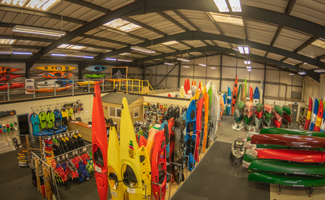Benefits of Wearing a Drysuit:
No matter what your discipline, you should always dress for the conditions you will be paddling in and are likely to encounter. Let’s face it, if you want to enjoy the sport anywhere in the UK between October and April, you are going to be faced with cold, windy and rainy conditions, often all together! This does not mean you should pack you boat away when the nights start to draw in, it just means you need to reconsider what you are wearing, and top up your thermals and technical outer wear.
An increasingly popular choice is the drysuit, which is technically mislabelled, as kayaking and canoeing suits are in reality surface immersion suits, designed to keep you warm and dry, with all the features you need, but not designed for continuous complete submersion.
A surface immersion suit will not only keep you dry, but will also keep the wind off, the other main chill factor in the water sports environment. However, do not think that the suit in its own right will keep you warm, it is important that you team it with a good thermal layering system, not forgetting the socks!
Features to Consider:
Zips: Although brass zips are traditionally seen as superior by many, the advanced, modern plastic dry zips used on immersion suits are more than adequate for use in paddling and becoming much more popular. There is some debate on the comparable durability of the plastic zips against the brass zips, with the brass zip being seen as more durable. Having said this, all zips are replaceable, as are seals and feet. Plastic zips are easier to close, lighter-weight and are more flexible. Both types will need care and maintenance, with many manufactures supplying a small amount of sample lubricant with their suits. There are three common zip entry positions: across the rear of the shoulders (Back Entry), diagonally across the chest (Front Entry) and through the waist (Hinge Entry). The choice is about comfort, ease of donning and removing and personal choice, and of course, each method has its devotees.
Seals: You will find that the majority of suits are fitted with latex seals (or gaskets as they are commonly known), which are the driest type of seal and are ideal for those who do a lot of rolling or are taking on more extreme conditions. There are now some drysuits available with neoprene/glideskin neck or wrist seals, which are not as dry but do offer higher comfort levels for those planning to be on the water (especially saltwater) all day and not expecting to take a dip. You will find some water egress with these 'semi-dry' seals if a lot of time is spent in the water.
Feet: Most drysuits come with integrated socks, either latex or fabric. Fabric socks are durable, but the material they are made from can de-laminate over time and begin to leak. These, much like zips and gaskets can be replaced, and will most likely wear-out before the main body of the drysuit expires. We recommended you wear a good pair of thermal socks inside your suit, and a pair of shoes on the outside and also take care not to stand on rough ground when changing into your drysuit.
Sizing:
With Manufactures only making a limited amount of sizes within their drysuit ranges, to get the perfect fit using the manufacturers Size Charts wearers will be extremely lucky. The majority of paddlers after consulting the size-carts will find themselves in-between sizes and perhaps need to try several sizes on to find the best fit.
Generally speaking, most paddlers will opt for the slightly larger size if given the choice after finding themselves between sizes. The technical fabrics that drysuits are made from have no stretch or give in them, so a suit that is too small will restrict movement and paddling strokes, allow for less warm clothing to be worn inside, and also will make a tight drysuit harder to get on or take off at the end of the day.
A drysuit that errs on the large side can be adjusted using internal braces (as found on Typhoon drysuits), sleeves, ankles and waists can be cinched in using Velcro adjuster tabs (if present). Also, any excess material found on the suits torso will be contained when the paddlers buoyancy aid is worn and tightened up.





